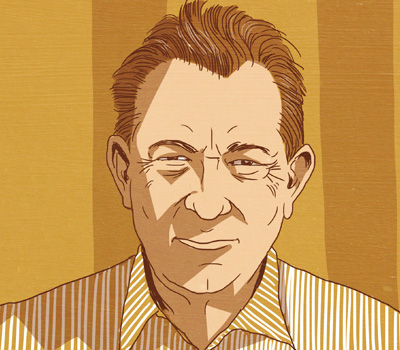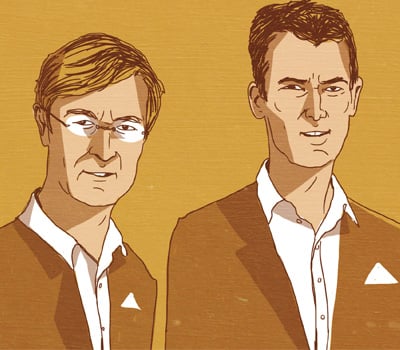Start with beautifully sunny weather for flowering. Add a miserable summer with a lot more rain than any Bordelais would want, especially a er the gloomy 2013 vintage. Then bring on a perfect, sunny autumn. You’ll end up with an unusual combination in Bordeaux: At their best, the 2014s are both ripe and fresh. While some of the wines are quite beautiful, no one would consider the vintage classic, nor could any vigneron cite a parallel among vintages past.


It is clear in the tasting room at Latour that the word “classic” is less important than “contemporary.” François Pinault, who purchased Latour in 1993, has one of the largest contemporary art collections in the world; he has moved this grand but once stodgy premier cru classé into his 21st century stable of businesses that include Christies, Gucci and Yves St-Laurent. Frédéric Engerer, president of Latour, has recently completed a major construction project, though it’s hard to tell from ground level. There’s a new barrel room one level down; two levels down is a vast cellar where ten vintages of Latour will eventually rest. Blessed with Pinault’s financial might, and with historically low interest rates, Engerer has pulled Latour out of the en primeur offerings, with the plan to release the wine when properly aged. It’s a radical step for a first growth, as is Latour’s transition toward biodynamics (Araujo in Napa Valley was farmed under biodynamics when Pinault purchased it). Hélène Génin, Latour’s technical director, now farms half of the core 124 acres under organics, the other half under biodynamics. Between the precision of the farming and the new winemaking facilities, the grand vin of Latour is no longer what it once was: a monumental wine, with powerful bass notes in the tannins and a structure that required long aging to reveal the dark Pauillac fruit. Instead, the 2014 Latour is a dynamic wine, pure and effortless. There is more tenor in the tannins, without the powerful bass notes of the old Latour. It’s finer in weight, bright in the finish.
Just to the south, at Léoville Las-Cases, the grand vin is more traditional in style, but equally kinetic in its way. Jean-Hubert Delon, proprietor of Las-Cases, was fascinated by the vintage. “In 1997 and 1999,” he said, “the vintages were saved by the fall weather. In the past, you could make a good wine, but never a great wine, after a difficult summer. 2014 is the first time I ever saw a great wine made in September and October, not in the summer. We had summer in September. It did not rain from the 26th of August on. In September, the grapes that were quite swollen began to shrink as they continued to ripen. Then, in October, we had a bit of wind.”
The 2014 Las-Cases is a challenging wine that does not show itself immediately. As it opens in the glass, it takes on a raciness, a quiet energy that drives the flavors forward, bright cassis and deeper tones lasting in unison.While we were tasting it, Delon said something that caught my attention, as well as Morrison’s. “The wines often gain acidity in barrel. In time, the 2014s may not be so welcoming,” he said. “They may be classical.”
That’s an interesting dichotomy: welcoming versus classical. It makes some sense in the Médoc, where enologists and proprietors have worked to make their wines accessible for the en primeur tastings. Cabernet sauvignon is not, by nature, a welcoming variety, especially when it’s young. But cabernet has evolved into the clearest messenger of terroir expression for these gravel promontories of the Médoc. Meanwhile, merlot can provide some hedonistic pleasure to a young blend. Delon commented that the wines of the Médoc “look more alike than they did in the past. It is the merlot that does that—the roundness and alcohol. There are certain wines here in the Médoc, if they have too much merlot in the blend, they lose their identity.”
Just north of the grand clos at Las-Cases, tight to the side of Latour, Pichon-Longueville Comtesse de Lalande has often produced one of the most welcoming wines of the Médoc. With 30 percent of the vineyard dedicated to merlot, and with the charming May de Lancquesaing at the helm for three decades, the wine was often chic and rarely brooding. Between the merlot component and the woman in charge, there was a propensity in the trade to refer to Pichon Comtesse as a feminine wine.
The Rouzaud family of Champagne Louis Roederer purchased a majority interest in Pichon Comtesse in 2006 and, after the harvest of 2012, installed Nicolas Glumineau as technical director. Glumineau, who had worked the prior six years at Montrose, has overseen the construction of a new cellar, finished in time for the 2014 harvest. He planned the new facilities in collaboration with Jean-Baptiste Lecaillon, the man responsible for the precision of the viticulture and winemaking at Champagne Roederer.
As Glumineau led us through the new cellar, describing the winegrowing process he has installed at Pichon Comtesse, one word kept reappearing in my notes. “We wanted the cellar to be less tight: larger and longer. We rebuilt around the process: We pick the grapes in boxes, use gravity to fill the tanks and to fill the barrels, below. We use conical-shaped tanks for precision of extraction (two meters diameter at the top, three meters at the bottom). Before, we had all 240-liter tanks, now we have 50-, 70-, 85-, 120- and 150-liter tanks. Everything is made to get more precision and balance in the wines.” Morrison commented later that the new cellar is regarded as one of the reasons why 2014 is such a success at Pichon Comtesse.


That character was apparent in the 2014 Pichon Comtesse, with a glorious sunny openness to the aroma, an exotic spice that wove into the tannins. What was remarkable about this 2014 was its lack of mintiness. There was nothing green in that aroma, and yet there was nothing overripe. Earlier vintages of Pichon Comtesse, even great vintages, had harbored some greenness, and their structures rarely came close to the savage muscle of the tannins in this 2014. In this vintage, the fruit shared the raciness of the Las-Cases, while the particular muscularity of the tannins was different.
When Glumineau commented that the harvest had lasted five weeks, longer than ever, Morrison added that “the number one advantage of the Indian summer was that we could pick when we wanted.” (Morrison helps her husband, Jacques Thienpont, make the wine at Le Pin in Pomerol.) “I can’t remember the last time we could delay at Le Pin with no risk of losing freshness.”
Glumineau headed to the cellar and reappeared with a bottle of 2010, citing it as his reference, the blend almost exactly the same as the 2014: 65 percent cabernet sauvignon, 25 percent merlot, 10 percent cabernet franc and petit verdot. Tasted next to the 2014, it was rich and succulent, while still tightly structured.


That work in the vineyard combined with the opportunities in the new cellar came together in 2014. “When everything is ripe, you don’t have to over-extract to get it rich,” Glumineau said. If the 2010 vintage itself could be said to be classic, the 2014 season is unlike anything that Bordeaux has experienced before. Even so, the 2014 Pichon Comtesse may set a new benchmark for this estate in years to come. Would that then mean it would be a classic Pichon?
Morrison brought up the discussion we had earlier in the day, about the meaning of “classic” in the Médoc, and how many proprietors would be offended if you call their wine classic. “You can’t call a wine classic anymore,” she said. “That’s pejorative.”
“Maybe they feel the word has been hijacked,” Glumineau hypothesized. “People are so used to hearing from Americans or the Asian market, ‘Oh, it’s a classic vintage.’ We’re all classicists. I use the image of an arrow in terms of tannic structure. You know where it is coming from, you know where it is going, you have the direction of the wine. You have flesh around the tannins. It’s like a parabola. This is classic Bordeaux.”
“For me,” Lecaillon said, “you have fair, good, great and classic vintages. Classic is the top. Classic is full identity. It represents, to the best of our ability, what makes our soil different from our neighbors’.”
“With the new generation, with my son [Guillaume], we can be more precise, more accurate.” Guillaume is working with a GPS system, and farming plant by plant. “Now we work within the plots and separate out the higher vigor. The fruit from the young vines and the vigorous vines goes into the second wine.”
For all the praise the wine has received, Thienpont remained philosophical. “Pas de folie,” he shrugged, gesturing at his glass. “It was too late in the season to have the fireworks of a sunny vintage.” “It’s a good year, 2014,” he said, “a cabernet franc year. The aroma is excellent—in Cheval Blanc, in La Fleur—that’s why I say it’s a franc year. I can feel the cashmere side of the franc in the wine. Cabernet franc alone is always a bit shy; merlot is stronger. In 2014, when we did the blend, the cabernet franc and the merlot seemed to be twins; the difference was not so big. For certain lots, tasting blind, I was unable to say if it was merlot or cabernet franc.” In a classic vintage, franc from the gravel parcels of Vieux Château Certan helps define the structure of the wine. It reveals the wine’s identity. In 2014, merlot and franc at VCC run in parallel, providing a different, contemporary take on the vineyard.
This story was featured in W&S Fall 2015.
illustrations by Michael Hirshon
Joshua Greene is the editor and publisher of Wine & Spirits magazine.
This story appears in the print issue of fal 2015.
Like what you read? Subscribe today.
















